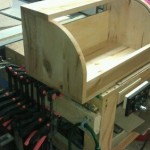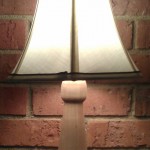 Until the person receives this, I really cant say what it is yet. My blog is linked to Facebook and twittter and they or someone they know could see this. Anyway I made some further progress on it tonight. What I can say is that the project will compose of at least 2 panels using mortise and haunched tenon joinery. After milling the boards for the 2 panels, I ran a groove in the edges to accept the panel and the haunch of the tenons. I did two passes on the table saw flipping face against the fence so that groove will be perfectly centered. From there I started working on the mortises. Since I didn’t have a long enough router bit, I decided that the best way to do these was with the drill press, a forstner bit, and a few chisels. It took several hours to complete, but this evening I was able to complete 8 mortises. The next step will be to start working on the tenons. I don’t currently have a tenoning jig, so I will likely putting one together that runs over the fence to accomplish this. I will update my blog once I have one made.
Until the person receives this, I really cant say what it is yet. My blog is linked to Facebook and twittter and they or someone they know could see this. Anyway I made some further progress on it tonight. What I can say is that the project will compose of at least 2 panels using mortise and haunched tenon joinery. After milling the boards for the 2 panels, I ran a groove in the edges to accept the panel and the haunch of the tenons. I did two passes on the table saw flipping face against the fence so that groove will be perfectly centered. From there I started working on the mortises. Since I didn’t have a long enough router bit, I decided that the best way to do these was with the drill press, a forstner bit, and a few chisels. It took several hours to complete, but this evening I was able to complete 8 mortises. The next step will be to start working on the tenons. I don’t currently have a tenoning jig, so I will likely putting one together that runs over the fence to accomplish this. I will update my blog once I have one made.
Category: 2012
Breadbox Project
Published on by Mike (Leave a comment)
 As mentioned in my previous post, I am working on a breadbox for my wife. I will make more updates as it nears completion. Today I finished the sanding, and decided to go ahead and start putting the finish on the box even though I haven’t started the door yet. The wood is maple that has some ambrosia figure to it. I got a pretty good deal on it from crlumber.com as he was trying to close out his remaining stock, and the figure was a bit limited. I am seriously thinking about making a trip back to get a little bit of walnut, as I am think the contrast in wood will really make the whole project pop out. I will post more pictures directly to the blog at some point. However, I am posting progress pictures via twitter. I have setup a twitpic event gallery just for the bread box. Click here to check it out!!
As mentioned in my previous post, I am working on a breadbox for my wife. I will make more updates as it nears completion. Today I finished the sanding, and decided to go ahead and start putting the finish on the box even though I haven’t started the door yet. The wood is maple that has some ambrosia figure to it. I got a pretty good deal on it from crlumber.com as he was trying to close out his remaining stock, and the figure was a bit limited. I am seriously thinking about making a trip back to get a little bit of walnut, as I am think the contrast in wood will really make the whole project pop out. I will post more pictures directly to the blog at some point. However, I am posting progress pictures via twitter. I have setup a twitpic event gallery just for the bread box. Click here to check it out!!
A bright turning – A Table Lamp
Published on by Mike (Leave a comment)
 The lamp is yet another turning as my lathe addiction grows. 🙂 This was a challenging, but fun project. There are actually three turnings total for this project. The first is the main body, the next one is the base, and finally a small turning that is used to attach the electrical components. All components were made from maple that has some (but not much) ambrosia figure in it. The finish is boiled linseed oil and a furniture paste wax.
The lamp is yet another turning as my lathe addiction grows. 🙂 This was a challenging, but fun project. There are actually three turnings total for this project. The first is the main body, the next one is the base, and finally a small turning that is used to attach the electrical components. All components were made from maple that has some (but not much) ambrosia figure in it. The finish is boiled linseed oil and a furniture paste wax.
The lamp’s main body was made for four 3/4″ boards laminated together. The two middle boards had a groove routed down the middle of them stopping an inch from each end. The idea being that after turning the main body, that I could drill a hole from either end that would allow the wire to run through, and attach the electrical components. The BIG mistake I made was I didn’t mark on the boards where the grooves were so that I could see where they were. I just assumed they would stay center enough for this. However, after glueing up the four boards, then jointing the edges, as well as trimming the ends, some how those groves became off center. Not enough to ruin the final turning, but just enough that they weren’t useable. Luckily I was able to find a drill bit that I already had that was long enough to meet in the middle, and was able to finish the drilling on the drill press.
The base of the lamp was turned from a rough 4/4 piece of maple. I flattened it on one face with the jointer, then straightened one edge. I wasn’t concern about squaring up the piece, just so I had a good edge to cut it to length on the miter saw and attach to the face plate. I roughed out the round pattern on the bandsaw. Once on the lathe, it was no problem getting the piece perfectly round and getting the face opposite to the faceplate parallel. Since this was a flat piece, with grain running perpendicular to the lathe, using spindle gouges was out of the question. The only turning tool I was able to use for this was my scraper. The main body had a large tenon, so I drilled mortise into the the base to accept the main body. Then I drilled a hole through the side of the base to allow for the electrical wire.
The hole at the top (and bottom for that matter) of the lamp body was 5/8″ in diameter. I needed a reducer peg so that I could put a threaded nipple into it. So I turned one to 5/8″ then drilled a hole just over a 3/8″ in diameter. The 5/8″ main hole was big enough to allow the nut and washer to fit, so it made attaching the threaded nipple a breeze. Before I glued in the reducer peg I attached the nipple to it. I SHOULD have ran the electrical wire through it first, as it would have been much easier to get pushed through. I didn’t but after a bit of rigging, I was able to get the wire pulled through.
The electrical components were for the most part were taken from an old lamp that was falling apart, though I had to buy a couple pieces from Lowes. The lampshade was bought from Target.
My wife is delighted to have it now. The room we have it was always a dark room because of the large brick wall for the fireplace. Having the additional light in the room makes a big difference for the overall lighting in the room.
